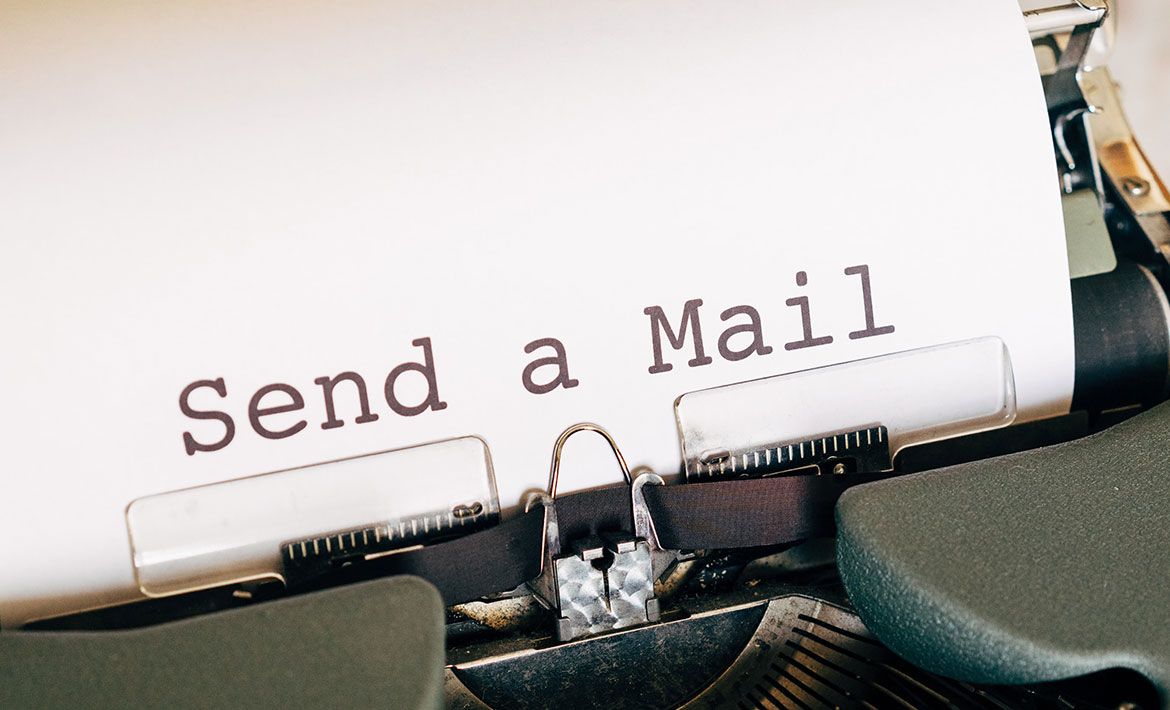Each day, the average office worker receives a whopping 121 emails. That means you’ve got your work cut out trying to catch your recipient’s attention. Sending ready-made email templates isn’t good enough; to beat the competition and to really stand out your email needs to be delicious.
Each line of your email needs to lead your recipient to the next one, all the way through to the sign-off. To make each line comprehensible and well-balanced, it’s crucial that they are formatted correctly.
You might be sending a cold email, a follow-up, a request, an introduction, whatever; here are the essentials your email can’t do without.
The five key ingredients of a finger-licking email:
- Subject line
- Greeting
- Body
- Closing line
- Signature
Looks easy? It’s nothing new. Let’s take a closer look at each specific step to preparing an email that gets responses.
1. A sprinkle of subject line
Look at your inbox, what do you see?
Subject lines!
The email subject line is your foot in the recipient’s door. The perfect subject line all comes down to the words you choose, the length you use, and the value you offer.
Despite being the shortest part of your email, the subject line plays a key role in deciding whether your email gets opened or thrown in the trash bin. You could have the most beautiful email ever, but without a catchy, professional subject line, it might never see the light of day.
The best email subject lines check all of these boxes:
- Between 1-5 words in length.
- Key intention of email body summarised.
- Tied nicely with the first line of the body.
- Clear message to the recipient as to which type of email is inside (initial, reply [re:], forward [fwd:], or follow up.
- Grab the attention of your prospects and pop out when they scan their inbox.
As a bonus tip, Darshan Somashekar, founder of brain training startup Solitaired, suggests testing a subject line that starts in lowercase. He explains "It helps the subject line stand out, and it makes the communication less formal"
Clear and concise is key to generating the perfect subject line. Describe concisely what’s waiting for the recipient inside your email, and keep mobile users in mind. Never exceed 7 words in your subject line.
Have a look at these subject lines that won’t let your recipient get past your email of any type
2. A pinch of hearty welcome
Figuring out how to start an email — especially when you're writing to someone you don't know very well — is a challenge.
Is "Hey" too casual? Is "Dear" overly formal? Is "Morning!" too cheery?
If you think the email greeting isn't important, you're wrong. How you begin an email sets the tone and shapes the recipient's perception of you. It may also determine whether they continue reading. So, yes, it is important.
Hi [Name],
We have a winner. Although it’s neutral and simple, it can’t go wrong.
Greetings you should avoid:
“To whom it may concern…”. It’s not the 19th century, man. This is a cold and impersonal way to start an email message. The recipient might think, "Well, this doesn't concern me ... I don't need to continue reading."
“Dear Mr./Mrs./Ms. [last name], …” / “Dear Sir or Madam, …”. Way too formal. In fact, all the “Dear…” sounds old-fashioned as well. Plus, this salutation tells the recipient that you have no idea who they are. Why should they be interested in what you have to say?
“[First Name]!”. This is informal and abrupt. Then when you tack on the exclamation point, it just gets annoying.
“Hi…”. This greeting also sounds abrupt; it lacks the customization that is necessary to grab a recipient’s attention.
Including the person's name in an email is a crucial way to get their attention.
3. Follow the saucy C&S rule for your email body format
On average, a user only reads 20% of the content on your page (Source: Nielsen Norman Group). The same fate awaits your email.
The first thought that appears in your mind is like: “20%? Is this some kind of joke? I’ve spent hours crafting a perfectly worded email only to have four-fifths of it ignored?!”.
Sadly, it’s true..
There is one very simple reason for this quite a depressing fact… scanning. Eye-tracking studies have found that the majority of people read online content in an ‘F’ pattern (Source: Nielsen Norman Group).
Your email recipient needs to receive a specific valuable piece of information and doesn’t want to read a lengthy email to find it.
Put yourself behind your recipient's eyes for a second.. You expect to find an answer to a question, some useful advice, an offer, or, ultimately, a solution. You scan the content for this goal. If you don’t find it quickly enough, you go straight back into your inbox.
Long story short, your email should be concise and scannable.
How do I do it?
- Keep the language simple and the content valuable. Remember, you are dealing with a busy person who will decide on the usefulness of your email within seconds. Try to make your content pleasing on the eye. People want to read an email easily, without struggling with technical jargon and marketing fluff.
- Use paragraphs made up of one or two sentences. Break your thoughts into new paragraphs and format important elements in bold (example: your offer, ask, updates, etc.). The white space makes it easier for a recipient to perceive the content of the email body;
- Don’t over-explain. Respect the recipient’s time. If your email is overwhelmed with too much info, it’s bound to get left unread, let alone unreplied. Don’t beat around the bush; get straight to the point. Where necessary, attach a document with more detailed information or offer to send one at the recipient’s request;
- Don’t make it too flashy. While graphics and unusual fonts are acceptable in marketing emails, a business email doesn’t need any of these trappings. Not all email clients will display your formatting properly, so stick to a default 11- or 12-point font and black text. Use bold text and italics sparingly.
Need more tips for writing flawless professional emails? Here is a full guide, along with a checklist; you can’t go wrong.
4. Spice it up with a particular closing
The sign-off is the last element which you can use to catch your recipient’s attention; your last chance to get your email replied to.
The correct closing line needs to be decided by the individual situation. Let’s think of some everyday professional contexts you might find yourself in. Here are some examples of how to end your email in the best way possible.
You’re waiting for a meeting or further cooperation with someone. To stay in contact with them, it’s important to offer the possibility of future communication:
You’re offering help to the recipient. For example, you might be sending them content or new information that is valuable to them.
You want to send a congratulatory note. Everybody likes receiving compliments and greetings. End your email with a final note that recognizes their accomplishment. This encourages further cooperation and conceives a positive attitude of you and your company.
The recipient has done something for you, so you need to express your gratitude to them:
Tip: Use Emoticons 😊
Emojis in business and marketing are becoming more and more popular. They help guide the tone of a message. You can make a message look more personalized and friendly, so use them if that’s the tone you’re going for. But here keep a balance to not overdo.
5. Put your email signature like a cherry on top
To reinforce the positive impression of yourself, include your email signature at the end of your email. Setting up a proper email signature is an opportunity for you to make it clear who you are, what you’re working on, and make it easy for people to reach you.
If you watch to catch their attention and remain in a customer’s head, you need to go beyond just your name and contact information. Transform a basic email signature into a marketing tool by inserting:
- a company logo;
- impressive awards you or your company won;
- your photo;
- brand elements;
- promotional banners;
- social media links.
But you don’t need to choose all the points mentioned. For example, if you include both a photo and a logo, it makes your signature too overloaded and confusing. Take care by keeping email signatures short and to-the-point; it would be unwise to have a signature that spans half a page.
Balance content and design. Effective email signatures are built on minimalist designs. Add 2 colours, for example: one in a logo and another one in the icons or the brand name. But be sure that the colors match each other.
Don’t forget the Call-To-Action. The CTA is exactly what encourages your customers to interact with you. The action you want them to take could be just about anything and depends on your goals. With a CTA, your client can download an ebook, become aware of some special offers and discounts, book a demo, and so on.
Hungry for more? Find how to create a memorable email signature, here!
Check out these easy, copy-paste templates!
Cold email
Writing cold emails is not just selling, it’s an art. You need to build a strong connection and make a prospect trust you without ever meeting them. Effective personalization with a touch of originality is the key to standing out in B2B sales. Try this template and get responses:
Hi [Name]!
When’s the last time you finished everything on your daily to-do list?
If you’re like most busy executives, you’re constantly struggling to stay on top of everything – let alone be the effective leader you need to be.
Our software helps motivated entrepreneurs like [Names] save as much as ten hours per week that can be directed back at your top priorities.
I’d love to give you a personalized demo. When are you free next week?
Sincerely,
[Your Signature]
Follow-up email
Sending sales follow-up emails is an effective way to engage or re-engage your prospects in a conversation that might eventually lead them to a closed deal. Maybe you could provide a group discount; relevant when you’re sure that your product is useful, not only for one person from the company but for several of them. Take a look at this email.
Hello, [Name]!
We’ve noticed that our product/service might be interesting for your peers as well. It can improve [insert something that needs improvement and can be solved by your product] and help your company hit revenue goals.
And guess what? We want to offer a 10% discount for your team! If you like the idea that we’re suggesting, we’d be happy to discuss it in further detail.
Sincerely,
[Your Signature]
Touch-Base email
If you’re getting back in touch after a while, the win-win option is to show your interest in their company through email. If your prospect has a blog or is active on social media, you can tactfully respond to something they post. Here’s how you can do it:
Hi [Name],
I hope you're doing well! I saw your [LinkedIn post, announcement, etc.] about [product launch, etc.]. Congratulations! It’s an exciting opportunity, and I'm looking forward to watching your progress as the business develops.
We've launched a few new tools and have been getting great feedback from our customers. I think they might be helpful in your approach, and I'd love to tell you more about [your service] to help you achieve greater goals.
What's the best time for you this week?
All the best,
[Your name]
Table of Contents
Crack the sales formula with CRM Lab
Twice a month, receive actionable CRM content to your inbox.



